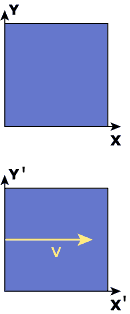| |
 |
Transformations relate quantities in systems that
are in relative motion.
|
|
|
|
A peculiar effect of Einstein's
postulates is the transformation that connects space-time
in two inertial frames. Such transformations are called Lorentz
transformations.
The standard Lorentz transformation in the x direction
is (for reference also the classical Galilei transformation
is included):
| Lorentz transformation (special
relativity) |
Galilei transformation (classical
Newtonian mechanics) |
 |
where  is the Lorentz factor.
Note that the spatial coordinates (y and z)
perpendicular to the direction of motion (x) are
unchanged. In the classical limit is the Lorentz factor.
Note that the spatial coordinates (y and z)
perpendicular to the direction of motion (x) are
unchanged. In the classical limit  , which means that , which means that  , special relativity is equivalent
with classical Newtonian mechanics. Furthermore, note
that , special relativity is equivalent
with classical Newtonian mechanics. Furthermore, note
that  , i.e. time is relative in
special relativity. , i.e. time is relative in
special relativity.
Directly from Lorentz transformations, one obtains the
concepts of length contraction, time dilation, relativistic
Doppler effect, and relativistic addition of velocities. |